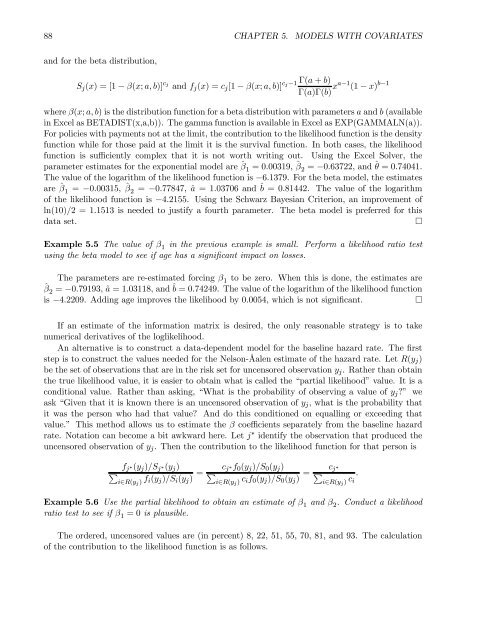Estimation, Evaluation, and Selection of Actuarial Models
Estimation, Evaluation, and Selection of Actuarial Models
Estimation, Evaluation, and Selection of Actuarial Models
Create successful ePaper yourself
Turn your PDF publications into a flip-book with our unique Google optimized e-Paper software.
88 CHAPTER 5. MODELS WITH COVARIATES<br />
<strong>and</strong> for the beta distribution,<br />
S j (x) =[1− β(x; a, b)] c j<br />
<strong>and</strong> f j (x) =c j [1 − β(x; a, b)] c Γ(a + b)<br />
j−1<br />
Γ(a)Γ(b) xa−1 (1 − x) b−1<br />
where β(x; a, b) is the distribution function for a beta distribution with parameters a <strong>and</strong> b (available<br />
in Excel as BETADIST(x,a,b)). The gamma function is available in Excel as EXP(GAMMALN(a)).<br />
For policies with payments not at the limit, the contribution to the likelihood function is the density<br />
function while for those paid at the limit it is the survival function. In both cases, the likelihood<br />
function is sufficiently complex that it is not worth writing out. Using the Excel Solver, the<br />
parameter estimates for the exponential model are ˆβ 1 =0.00319, ˆβ 2 = −0.63722, <strong>and</strong>ˆθ =0.74041.<br />
The value <strong>of</strong> the logarithm <strong>of</strong> the likelihood function is −6.1379. For the beta model, the estimates<br />
are ˆβ 1 = −0.00315, ˆβ 2 = −0.77847, â =1.03706 <strong>and</strong> ˆb =0.81442. The value <strong>of</strong> the logarithm<br />
<strong>of</strong> the likelihood function is −4.2155. Using the Schwarz Bayesian Criterion, an improvement <strong>of</strong><br />
ln(10)/2 =1.1513 is needed to justify a fourth parameter. The beta model is preferred for this<br />
data set. ¤<br />
Example 5.5 The value <strong>of</strong> β 1 in the previous example is small. Perform a likelihood ratio test<br />
using the beta model to see if age has a significant impact on losses.<br />
The parameters are re-estimated forcing β 1 to be zero. When this is done, the estimates are<br />
ˆβ 2 = −0.79193, â =1.03118, <strong>and</strong>ˆb =0.74249. The value <strong>of</strong> the logarithm <strong>of</strong> the likelihood function<br />
is −4.2209. Adding age improves the likelihood by 0.0054, which is not significant. ¤<br />
If an estimate <strong>of</strong> the information matrix is desired, the only reasonable strategy is to take<br />
numerical derivatives <strong>of</strong> the loglikelihood.<br />
An alternative is to construct a data-dependent model for the baseline hazard rate. The first<br />
step is to construct the values needed for the Nelson-Åalen estimate <strong>of</strong> the hazard rate. Let R(y j )<br />
be the set <strong>of</strong> observations that are in the risk set for uncensored observation y j . Rather than obtain<br />
the true likelihood value, it is easier to obtain what is called the “partial likelihood” value. It is a<br />
conditional value. Rather than asking, “What is the probability <strong>of</strong> observing a value <strong>of</strong> y j ?” we<br />
ask “Given that it is known there is an uncensored observation <strong>of</strong> y j , what is the probability that<br />
it was the person who had that value? And do this conditioned on equalling or exceeding that<br />
value.” This method allows us to estimate the β coefficients separately from the baseline hazard<br />
rate. Notation can become a bit awkward here. Let j ∗ identify the observation that produced the<br />
uncensored observation <strong>of</strong> y j . Then the contribution to the likelihood function for that person is<br />
f j ∗(y j )/S j ∗(y j )<br />
P<br />
i∈R(y j ) f i(y j )/S i (y j ) = c j ∗f 0 (y j )/S 0 (y j )<br />
P<br />
i∈R(y j ) c if 0 (y j )/S 0 (y j ) =<br />
c j ∗<br />
P<br />
i∈R(y j ) c i<br />
.<br />
Example 5.6 Use the partial likelihood to obtain an estimate <strong>of</strong> β 1 <strong>and</strong> β 2 . Conduct a likelihood<br />
ratiotesttoseeifβ 1 =0is plausible.<br />
The ordered, uncensored values are (in percent) 8, 22, 51, 55, 70, 81, <strong>and</strong> 93. The calculation<br />
<strong>of</strong> the contribution to the likelihood function is as follows.
















